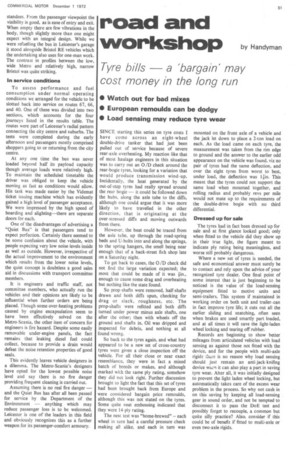road and
Page 53

If you've noticed an error in this article please click here to report it so we can fix it.
workshop by Handyman
Tyre bills a 'bargain' may cost money in the long run
• Watch out for bad mixes • European remoulds can be dodgy • Load sensing may reduce tyre wear
SINCE starting this series on tyre costs I have come across an eight-wheel double-drive tanker that had just been pulled out of service because of severe rear-axle overheating. My reaction like that of most haulage engineers in this situation was to carry out an 0 /D check around the rear-bogie tyres, looking for a variation that would produce transmission wind-up. Incidentally, the heat generated by the out-of-step tyres had really spread around the rear bogie — it could be followed down the hubs, along the axle tube to the diffs, although one could argue that it was more likely to have travelled in the other direction, that is originating at the over-stressed diffs and moving outwards from there.
However, the heat could be traced from the axle tube, up through the road-spring beds and U-bolts into and along the springs, to the spring hangers, the smell being near enough that of a back-street fish shop late on a Saturday night.
To get back to cases, the 0 /D check did not find the large variation expected; the most that could be made of it was enough to cause some drag and overheating but nothing like the state found.
So prop-shafts were removed, half-shafts drawn and both diffs spun, checking for drag or slack, roughness, etc. The prop-shafts were refitted and both diffs turned under power minus axle shafts, one after the other; then with wheels off the ground and shafts in. Oil was dripped and inspected for debris, and nothing at all found wrong.
So back to the tyres again, and what had appeared to be a new set of cross-country tyres were given a close inspection off the vehicle. For all their close or near exact resemblance, they were in fact a mixed batch of breeds or makes, and although marked with the same ply rating, somehow they did not look right. Further discussion brought to light the fact that this set of tyres had been brought back from Europe and were considered bargain price remoulds, although this was not stated on the tyres. Some quite neat embossing indicated that they were 14-ply rating.
The next test was "home-brewed" -each wheel in turn had a careful pressure check making all alike, and each in turn was mounted on the front axle of a vehicle and the jack let down to place a 2-ton load on each. As the load came on each tyre, the measurement was taken from the rim edge to ground and the answer to the earlier odd appearance on the vehicle was found, viz no pair of tyres had the same deflection, and over the eight tyres from worst to best, under load, the deflection was liin. This meant that the tyres could not support the same load when mounted together, and rolling radius and probably revs per mile would not mate up to the requirements of the double-drive bogie with no third differential.
Dressed up for sale The tyres had in fact been dressed up for sale and at first glance looked good; only when fitted to the vehicle did they show up in their true light, the figure meant to indicate ply rating being meaningless, and worse still probably dangerous.
Where a new set of tyres is needed, the safe and economical answer must surely be to contact and rely upon the advice of your recognized tyre dealer. One final point of some interest that is just beginning to be noticed is the value of the load-sensing equipment fitted to motive units and semi-trailers. This system if maintained in working order on both unit and trailer. can in fact improve tyre life; it cuts out all the earlier sliding and snatching, often seen when brakes are used smartly part loaded, and at all times it will save the light-laden wheel locking and tearing off rubber.
Records are beginning to show better mileages from articulated vehicles with load sensing as against those not fitted with the device, and for the people with multi-axle rigid s there is no reason why load sensing should just remain an anti-jack-knifing device wi,;:n it can also play a part in saving tyre wear. Atter all, it was initially designed to prevent the light laden wheel locking, but automatically takes care of the excess wear problem in the process. So why not cash in on this saving by keeping all load-sensing gear in sound order, and not be tempted to disconnect it to pass the DoE test and possibly forget to recouple, a common but quite silly practice? Also consider if this could be of benefit if fitted to multi-axle or even two-axle rigids.
































































































































